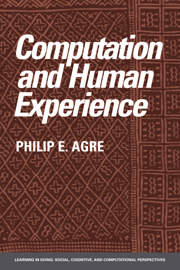Book contents
- Frontmatter
- Contents
- Preface
- 1 Introduction
- 2 Metaphor in practice
- 3 Machinery and dynamics
- 4 Abstraction and implementation
- 5 The digital abstraction
- 6 Dependency maintenance
- 7 Rule system
- 8 Planning and improvisation
- 9 Running arguments
- 10 Experiments with running arguments
- 11 Representation and indexicality
- 12 Deictic representation
- 13 Pengi
- 14 Conclusion
- Notes
- References
- Author index
- Subject index
1 - Introduction
Published online by Cambridge University Press: 07 December 2009
- Frontmatter
- Contents
- Preface
- 1 Introduction
- 2 Metaphor in practice
- 3 Machinery and dynamics
- 4 Abstraction and implementation
- 5 The digital abstraction
- 6 Dependency maintenance
- 7 Rule system
- 8 Planning and improvisation
- 9 Running arguments
- 10 Experiments with running arguments
- 11 Representation and indexicality
- 12 Deictic representation
- 13 Pengi
- 14 Conclusion
- Notes
- References
- Author index
- Subject index
Summary
Activity
Computational inquiry into human nature originated in the years after World War II. Scientists mobilized into wartime research had developed a series of technologies that lent themselves to anthropomorphic description, and once the war ended these technologies inspired novel forms of psychological theorizing. A servomechanism, for example, could aim a gun by continually sensing the target's location and pushing the gun in the direction needed to intercept it. Technologically sophisticated psychologists such as George Miller observed that this feedback cycle could be described in human-like terms as pursuing a purpose based on awareness of its environment and anticipation of the future. New methods of signal detection could likewise be described as making perceptual discriminations, and the analytical tools of information theory soon provided mathematical ways to talk about communication. In the decades after the war, these technical ideas provided the intellectual license for a counterrevolution against behaviorism and a restoration of scientific status to human mental life. The explanatory power of these ideas lay in a suggestive confluence of metaphor, mathematics, and machinery. Metaphorical attributions of purpose were associated with the mathematics of servocontrol and realized in servomechanisms; metaphorical attributions of discrimination were associated with the mathematics of signal and noise and realized in communications equipment; and metaphorical attributions of communication were associated with the mathematics of information theory and realized in coding devices. The new psychology sought to describe human beings using vocabulary that could be metaphorically associated with technologically realizable mathematics.
The development of the stored-program digital computer put this project into high gear.
Information
- Type
- Chapter
- Information
- Computation and Human Experience , pp. 1 - 26Publisher: Cambridge University PressPrint publication year: 1997
